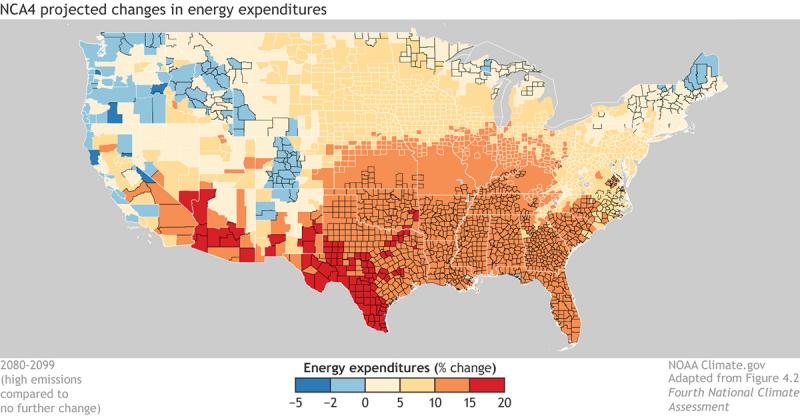Energy Consumption
Utility records show that increased temperatures increase overall energy consumption in the United States. As global temperatures increase, locations can expect fewer extremely cold days (<10° F) during winter and more extremely hot days (>95° F) during summer. For the Southeast, Great Plains, and the Southwest, the number of extremely hot days is projected to increase substantially compared to the decrease in the number of extremely cold days.
Warmer winters, hotter summers
As temperatures increase, changes in energy consumption will depend on the season. Warmer winters decrease the need for heating, reducing energy consumption. Conversely, hotter summers increase demand for cooling, so energy consumption goes up. As energy savings during warmer winters are not expected to offset increased consumption during hotter summers, many regions can expect a net increase in energy consumption. As a result of higher temperatures, economists estimate that net energy costs to consumers will increase by 10 to 22 percent.
The current mix of energy sources used in each region may also change with increased temperatures. Winter heating is powered by a mixture of electricity, fuel oil, and natural gas, whereas summer cooling is powered by electricity. The expected consequence of this situation is reduced demand for fuel oil and natural gas and increased demand for electricity. Using wind and solar to generate electricity to meet this demand could shift consumption from fossil fuels to potentially more renewable sources of energy.
Effects on energy infrastructure
Increased energy consumption may strain energy infrastructure, especially during periods of peak energy demand. For instance, on days when temperatures exceed 95°F, demand for electricity may exceed the capacity of energy-generating facilities and the electrical grid. Disruptions in service—including the potential for widespread blackouts—may result. Increased instances of peak demand for electricity could also affect production and transmission costs, ultimately increasing costs for consumers.
Other factors in energy consumption
Changes in energy consumption also depend on factors other than climate change. Population change, economic growth, and international energy pricing all affect energy consumption patterns. Adaptive responses—such as diversifying supply chains, improving electrical grid reliability, adding more electricity-generating facilities, increasing transmission capacity between regions, energy conservation, and increasing reliance on renewable sources of energy—could reduce the impacts of climate change and extreme weather on the energy system.
The preceding text is excerpted and abridged from Climate Change Impacts in the United States: The Third National Climate Assessment (Chapter 2: Our Changing Climate and Chapter 4: Energy Supply and Use).


